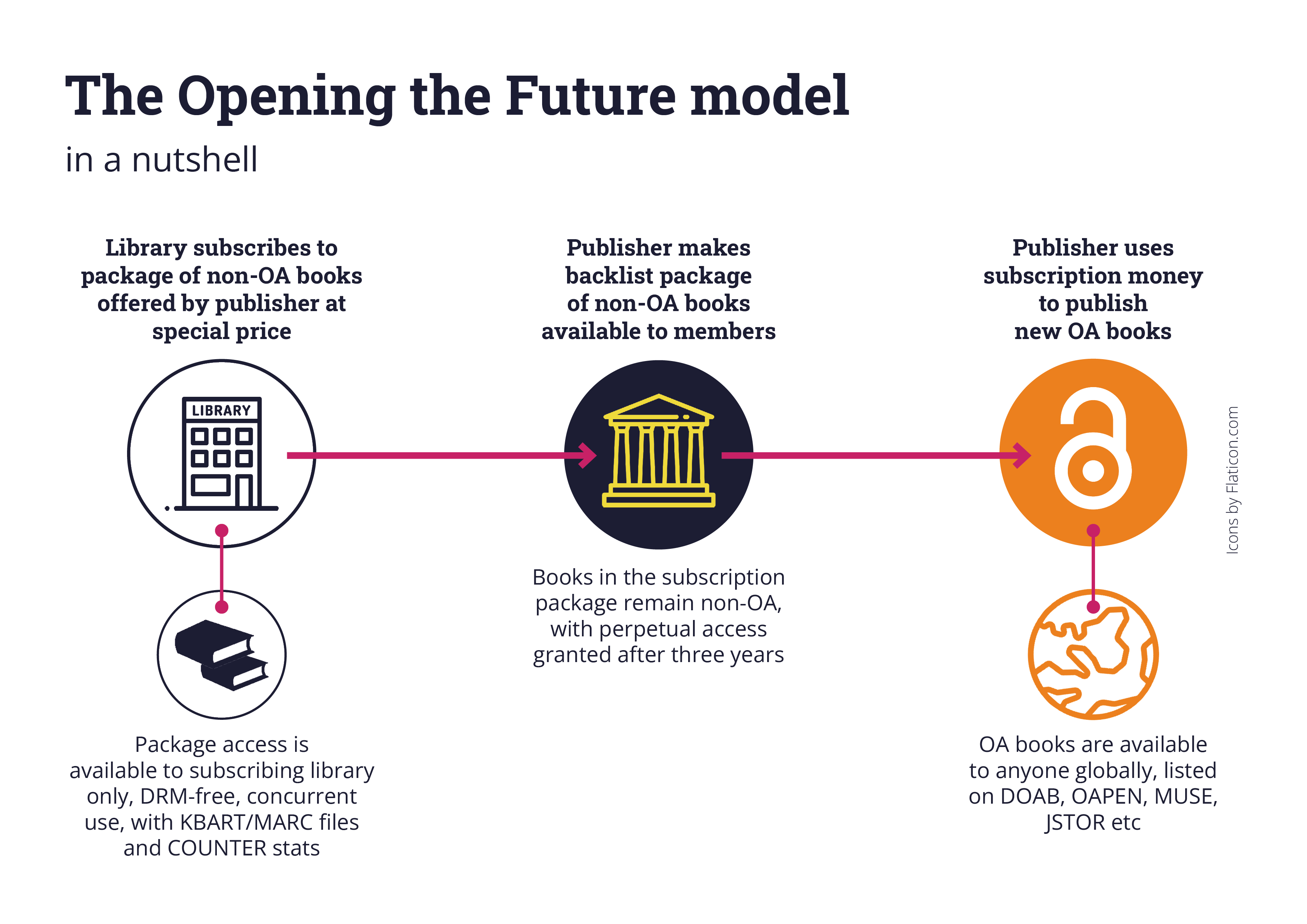What is Opening the Future?
- It is a revenue model utilising a Press' closed backlist to fund the open access frontlist.
- The Press creates backlist packages that libraries can subscribe to.
- The library subscriptions are then used solely to publish frontlist titles OA.
How the Opening the Future (OtF) model works is fundamentally very simple, on both the publisher and the library side. It is a revenue model for open access monographs in which a press solicits a relatively small financial contribution from a moderate number of academic libraries, in order to cover the costs of new OA publications.
How it works, in a nutshell
Libraries sign up to get unlimited, DRM-free access to curated packages of a press’s backlist, with perpetual access after three years and the option to renew (on which more later in this Toolkit). The press then uses the revenue from the membership subscription fees solely to produce frontlist titles in open access format immediately on publication. We informally call it the ‘Backlist to the Future’ model as it uses the backlist to fund the frontlist. Publishing the OA titles is a rolling process: as soon as the publisher accrues the funds to produce a book, they can publish the next one in line, and so on. Therefore, unlike many other collective models, there is no target member threshold to reach other than simply the production cost of the next book, which means the more members they have, the more books a press can publish OA.
Benefits to the library
This detail, about libraries retaining perpetual access after their initial subscription term, is in fact key to how the whole thing works. While we call this a subscription, or a membership model, it is in reality an acquisition by the library. As it ends up being a purchase after the three years, a library can pay for this out of a conventional subject acquisition budget rather than needing a dedicated OA fund (many libraries don't have dedicated OA funds yet - although these can also be used to financially support OtF). So it fits elegantly into expected channels and budgets for libraries on several levels. It also means that the model can reach several different budgets within the library. This can justify the expenditure as a purchase of books to which they would otherwise not have access. The backlist/frontlist combination also provides a unique dual-route to rationalisation for acquisition librarians. Anecdotally, several librarians have told us that this is a major draw and strength of the model. At the same time, every year of membership grows their (open) collection by whatever frontlist titles are funded via Opening the Future. This is how libraries with OA budgets are able to justify this expenditure because the new frontlist titles are openly accessible. This also allows institutions that have access to block grants for OA to use this pot to fund the purchase. It is further possible for funders directly to support such consortial membership schemes.
Benefits to the publisher
From a publisher perspective, it operates very differently from other collective funding initiatives such as Knowledge Unlatched, which is a point of comparison some publishers we have spoken to have raised, and which publishers may be familiar with. With OtF, the financial dealings are directly between the publisher and the library, and the publisher holds the funds directly and makes decisions on which titles to spend them on. This differs from KU where applications are made per title by the publisher, who is granted funds administered by KU. This gives the publisher greater control (also in comparison to charging BPCs) over what work they are able to publish open access, which is particularly important in mission-driven presses where you may have a strong desire to make certain titles as widely accessible as possible, but not currently the financial means to do so.
A low-risk, sustainable OA funding stream for publishers
The aim of this approach is to continue to yield a sustainable source of revenue for a press while achieving the desired commitment to making more titles OA. Given the current global library environment and budget pressures, a consortial model of funding promises a cost-effective solution for OA that means no single institution bears a disproportionate burden. The model also yields an elastic approach to open access that can grow with the success of the model. This elasticity is also a vital piece of its design. The Copim project aimed to support small to medium presses with this (both institutional and small mission-driven commercial presses), those who operate on tight margins, with limited cushion for experimentation, and who need to incur as little risk as possible in adopting new funding models. This is one of the reasons why library membership/subscription to the programme lasts a minimum of three years, with the option to renew after that: the press is able to plan ahead for at least three years with some measure of financial certainty. Risk is further mitigated by the level of investment by the publisher. You only use a selection of your back content to create subscription packages, rather than imposing an ‘all or nothing’ approach. Additionally, you are still able to sell individual copies of your backlist titles and print copies of the OA frontlist titles that the subscription funds, meaning that committing backlist titles to the packages interrupts normal revenue streams to a small degree.

No Comments